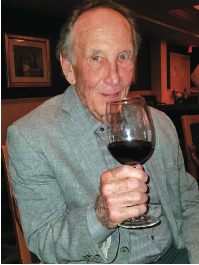S.W AND RICH HERMANSEN
Staff Writers
wine@lbknews.com
Two schools of thought about what makes a good cocktail: the minimalists ask for a specific spirit in the drink, say, Maker’s Mark Bourbon or Glenfiddich Scotch or Ketel One Vodka; the craft cocktail crowd has a stronger interest in the mixers and garnishes that the bartender adds to whatever spirits the drink contains.
or Glenfiddich Scotch or Ketel One Vodka; the craft cocktail crowd has a stronger interest in the mixers and garnishes that the bartender adds to whatever spirits the drink contains.
Please let us elaborate a bit on these stereotypes before jumping to one side or the other. Most of us would agree that a premium spirit should not be subjected to distractions. Rather than drinking a great Bourbon or Scotch neat (as poured from the bottle), a dash of cool water enhances the taste as I’ve learned drinking Bourbon and branch in Kentucky and good Scotch in a bar in St. Andrews where the natives have no qualms about instructing tourists on how to drink Scotch. On the other hand, with few exceptions, ordering a premium spirit in a craft cocktail wastes money unless the recipe for the drink calls for it, as in Hendrick’s Gin in a Gin and Tonic with a slice of cucumber. Often the mixers and garnishes in a craft cocktail mask the tastes of the premium spirit.
Let the taste of a spirit that you are paying dearly for its nuances shine in the glass. Save your money when the bartender asks which premium brand of Tequila (Casamigos?, he or she asks) in your Margarita. Defer to the rail Tequila. You won’t taste the difference.
Perhaps you should be asking about the mixers and garnishes that the bartender is using to make your mixed drink. In Margarita, is the bartender using fresh lime juice and a quality agave nectar? You can make a Margarita with a Margarita mix at home.
Craft cocktail drinkers usually study the recipe for a drink on the menu. The recipes may call for muddling of fresh fruit, say blackberries in a Bramble, small quantities of liqueurs or fortified wines such as Vermouth, Cointreau, and bitters, and garnishes such as charred orange peel, sugar cane stirrers, and fresh herbs. The fusion of these aromas and tastes. The show of preparing the drink and serving it plays a major role in crafting cocktails.
Because much of the appeal of a craft cocktail comes from the mixers and garnishes, it makes sense to hold the bar and bartender to high quality standards for these ingredients in these pricy drinks. Hoses connected to tanks under the bar should be used for still and sparkling water only, not for tonic, cola, ginger ale/beer, and other mixers. Spirits infused with fruit should be made in house in most instances, as should the simple syrup ubiquitous in many drink recipes. Agave nectar, honey, or molasses may prove to be better choices in many drinks. Fresh herbs, berries, and citrus slices garnish an artful cocktail. Recipes often include special spices and bitters to enchant the nose and tongue.
Glassware must match the drink. Martini, Old Fashioned, Highball (Tonics, Mojitos, Bloody Mary), and Coupe (Champagne cocktail, Fizz, Spritzer) glasses have shapes designed for specific types of cocktails. A craft cocktail bar must have those and more. This web site shows a gallery of cocktail glass shapes: https://www.tasteofhome.com/collection/types-of-cocktail-glasses/
When and where possible, we choose seats at a bar close to the area used to prepare drinks. A good mixologist will explain why each step in a recipe contributes to the resulting magic potion. We enjoy the show as much as the drink.
S. W. Hermansen has used his expertise in econometrics, data science and epidemiology to help develop research databases for the Pentagon, the National Institutes of Health, the Department of Agriculture, and Health Resources and Services. He has visited premier vineyards and taste wines from major appellations in California, Oregon, New York State, and internationally from Tuscany and the Piedmont in Italy, the Ribera del Duero in Spain, the Barossa Valley and McLaren Vale in Australia, and the Otego Valley in New Zealand. Currently he splits time between residences in Chevy Chase, Maryland and St. Armand’s Circle in Florida.
Rich Hermansen selected has first wine list for a restaurant shortly after graduating from college with a degree in Mathematics. He has extensive service and management experience in the food and wine industry. Family and friends rate him as their favorite chef, bartender, and wine steward. He lives in Severna Park, Maryland.

